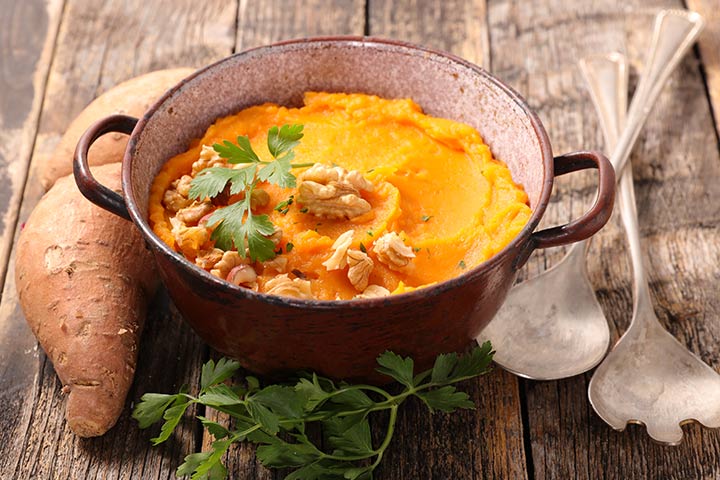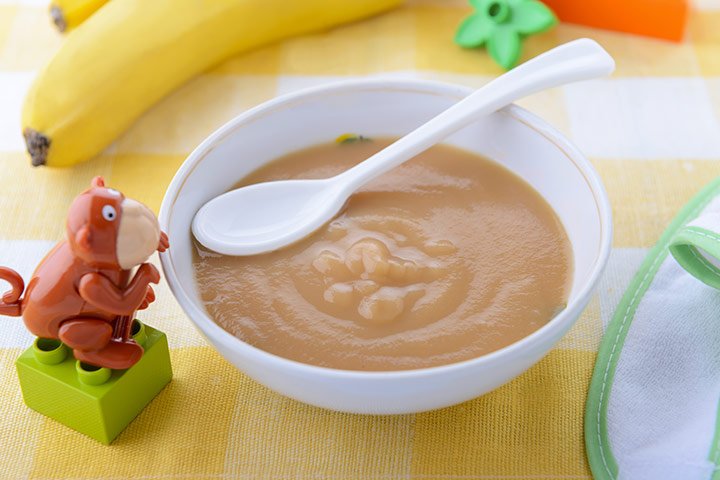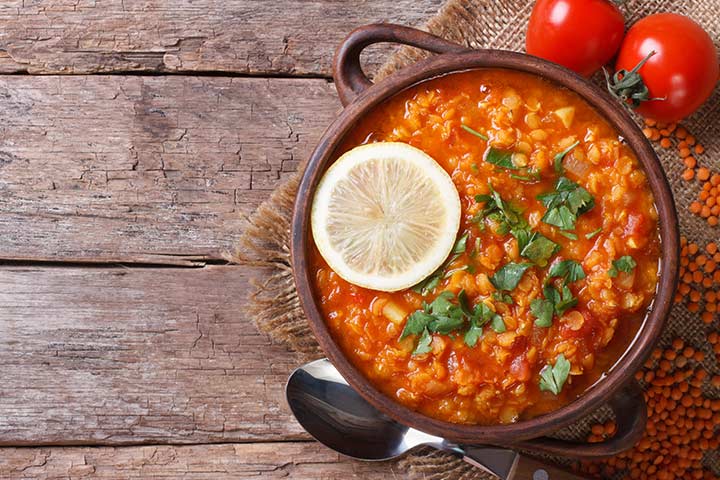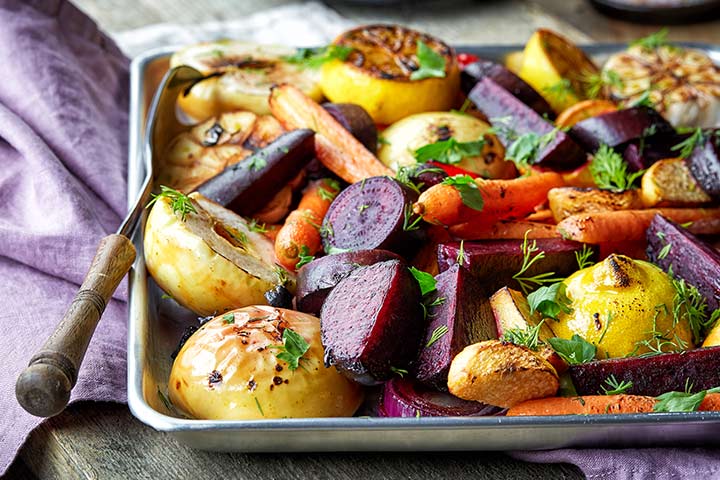Fiber is an essential nutrient that adds bulk to the stools and facilitates their smooth passage. Besides, it acts as a natural prebioticiXA non-digestible food component good for the gut’s healthy bacteria that promotes good bacteria (probiotics) growth and supports gut health. Therefore, selecting age-appropriate high-fiber foods for babies is essential. Perhaps it is the reason that the American Dietetic Association (ADA) recommends people across age groups consume sufficient amounts of dietary fiber from various plant foods (1) (2).
Scroll down to read more about dietary fiber and its possible benefits for babies, its side effects, and some high-fiber recipes you can feed to your baby. But before we dwell on details, let’s first understand the basics and learn some basic facts about fiber and its types.
Is Fiber Good For Babies?
Fiber is good for babies. The inclusion of dietary fiber in a baby’s diet can help enhance the gut microbiome and keep the digestive system healthy. Research suggests that the first years of life are crucial for establishing a healthy colonic microflora, as well as good eating habits (3). Thus, the intake of dietary fiber for babies is beneficial.
In a 2021 report, the Centers for Disease Control and Prevention (CDC) found that among children aged one to five years, one in three (32.1%) and almost half (49.1%) did not consume a daily fruit and vegetable, respectively. Since fruits and vegetables are crucial sources of fiber, parents must prioritize including them in the child’s meal plan to facilitate their healthy growth and development.
Dietary Fiber And Its Types
Dietary fiber or fiber is a type of complex carbohydrate found in plant foods (4). It cannot be easily digested in the small intestine, and this brings in the health benefits associated with it.
There are two forms of dietary fiber, soluble and insoluble. Most plant foods contain some amount of each type, which can provide specific health benefits.
How Much Fiber Do Babies Need?
There are no clear guidelines on the recommended amount of dietary fiber for babies younger than one year (5) (6). Nutrition experts recommend five grams of fiber a day for children below the age of two years (7). It is best to consult a pediatric nutritionist to know about the ideal limit for your baby.
Jesse Feder, a registered dietician from North Miami Beach, Florida, says, “When babies are just consuming breast milk or formula for up to six months, they will not need fiber. However, after six months, they will need around five grams per day until they are one year old.
“After the age of one, there are no real set standards for fiber intake. However, the best rule I tell parents is to take their child’s age and add five to ten grams to it to estimate how much fiber they should be getting.”
Uses Of Fiber For Babies
Fiber is an important part of an individual’s diet. It is helpful in the following ways for the baby:.
- Supports digestive health: Insoluble fiber, a type of dietary fiber present is whole grains, whole pulses, raw fruits, and vegetables is vital for maintaining digestive health. Upon ingestion,iXThe process of taking a substance through the mouth it swells up in the intestine by trapping water and adds bulk in the diet leading to smooth passage of stool. It helps prevent constipation, and supports the pH of the intestine, and prevents colonizationiXThe process of establishment of the microbe in the body tissues of harmful microbes (8) (9).
- Good for gut microflora: The total dietary fiber, i.e., soluble and insoluble fiber, works as prebiotics or food for millions of probiotic bacteria living in the human gut. According to a research study published in the Journal of Cell Host and Microbe, the type, quality, and origin of food impacts the gut microbes (10).
- Strengthen immunity:Dietary fiber works as prebiotics and helps enhance immunity by increasing the population of beneficial microbes, such as lactic acid bacteria and bifidobacteria (11) (12). These bacteria could help fight harmful pathogens, and thus boost immunity.
- Supports absorption: A healthy gut harbors healthy microbiomesiXA population of microorganisms found in a specific habitat that assist in the proper digestion of food and absorption of nutrients (13) (14). Both these processes are vital for maintaining overall health and well-being.
- Improves appetite: Soluble fiber helps keep the tummy full. On consumption, it combines with water and forms a gel-like structure that delays gastric emptying. This mechanism increases the total amount of time the food stays in the gut and thus facilitates the sensation of satiety. It also helps in the secretion of appetite-regulating hormones within the gastrointestinal tract (15).
There are several sources of dietary fiber for babies. In the next section, we tell you about the fiber-rich foods you can feed your baby.
High Fiber Foods For Babies
A well-balanced, fiber-rich diet for a baby includes foods from the following food groups.
1. Grains (and cereals)
You can include cereals and grains in a baby’s diet as they begin eating solids. It will add variety in the meals and ensure the intake of fiber along with other vital nutrients. A few options that you can try are oatmeal, brown rice, barley, whole wheat, and maize. Besides, you can also try adding some pseudocereals such as quinoa, buckwheat, and amaranth (16).
2. Vegetables
Babies can consume all vegetables pretty much at the onset of starting solids. Vegetables are a good source of micronutrients and dietary fiber. Besides, they are not high in simple carbohydrates. A few high-fiber vegetables that you could try for your baby are spinach, broccoli, beans, edamame, sweet potato, corn, and carrots. Give these vegetables in cooked and pureed form since babies might find it difficult to digest raw vegetables. Or if using the baby-led weaning approach to feeding, give the vegetables cooked until soft and cut into wedge-sized pieces for younger babies, or bite-sized pieces for older babies.
3. Fruits
Fruits contain dietary fiber and also several micronutrients. It is good to include at least one fruit a day in your baby’s diet. Some high-fiber fruits that you can consider are watermelon, muskmelon, apple, banana, strawberries, avocado, and blackberries.
Arvi, a mother of two, initiated baby-led weaning for her daughter, Ava, with avocado. Narrating her approach, she says, “We started exactly on Ava’s sixth month. She was already showing signs of readiness prior, so we decided to go for it. Ava’s first food was avocado sliced into wedges big enough for her to grasp. We placed them on her tray and anxiously waited for her to pick them up. After a little staring at the avocado, she eventually picked it up and ate it (i).”
4. Dried fruits
Dried fruits are potential choking hazards for babies around 6-12 months of age (17). But you can serve them in cooked and pureed form. Once your baby has started finger foods, you can cook dried fruits or chop them into small pieces to feed the baby. Some of the high-fiber options are prunes, apricots, dates, and figs.
5. Pulses and legumes
Pulses and legumes are considered a good source of protein and micronutrients like iron, potassium, and folate. However, they are also good sources of dietary fiber. Some options from this food group that you could include in your baby’s diet are horse gram, Bengal gram (whole), kidney beans, split peas, lentils, and chickpeas.
Possible Side-Effects Of Excessive Fiber Intake
People who consume fiber are less susceptible to chronic diseases (1). But you shouldn’t go overboard because it could have some adverse outcomes (18).
- High fiber and low water intake may lead to constipation or diarrhea.
“Too much fiber can constipate a baby. Fiber-rich foods take longer to digest and can sit in the digestive tract for longer. This can absorb a lot of water and start to cause constipation. Additionally, constipation can cause the baby to feel too full and not want to eat as much,” opines Feder.
- It might lead to a decrease in mineral absorption, which could be detrimental to the baby’s health.
- Consuming excessive fiber may cause flatulence,iXRemoving gas from the digestive system through the back passage bloating, abdominal cramps, and nausea.
- It may cause a decrease in appetite in some cases and might lead to growth failure.
Precautions To Take While Introducing Fiber Foods To Babies
- Observe variety and moderation in the foods you give your baby.
- Start with a single grain (or cereal) for young babies. As the baby grows older, you can start multigrain meals.
- Minimize fiber loss by not peeling fruits and vegetables. Scrape them instead.
- Consult a pediatrician before starting a new fiber food for your baby.
- Water intake, along with fiber intake, is important. Fiber needs water to function (19). Offer small amounts of water (1-2oz) in an open cup with meals. Breast milk or formula are still the primary sources of nutrition for the entire first year, so make sure to give a milk feed an hour or so before offering solids to maintain hydration levels.
- Babies must have fiber from natural foods only. Avoid using isolated or commercial fiber.
Ways To Include High Fiber Foods In Baby’s Diet
The following are a few interesting recipes to include fiber in your baby’s diet.
For babies five to six months old
Babies at this age do not develop eating skills and digestive systems. So, the best way to introduce food to them is in the puree or mashed form. It ensures easy swallowing and digestibility.
For optimum fiber intake, vegetables like sweet potato, carrot, and green peas can be included in the diet. You can also include fruits like apples, bananas, and raspberries.
1. Sweet Potato Puree
You will need:
- 1 sweet potato
- 1tsp extra virgin olive oil
- ¼tsp cumin (optional)
How to:
- Wash the sweet potato in cold water and with a thin, bristled brush scrape its skin to remove dust and dirt from the surface.
- Once it is clean, dice the sweet potato into pieces of approximately two inches in size.
- Put these pieces into a pan and place the pan on a medium flame. Add enough water to cover the pieces and cover the lid of the pan.
- Let the pieces cook for 15-20 minutes. Check with a fork if the pieces are soft.
- Once done, put the pieces with water in a blender and blend until you get a smooth paste.
- Take another pan, pour oil in it, and place the pan on low flame.
- As the oil gets heated, add cumin. Once cumin starts to flutter, add the puree in the pan.
- Keep stirring the puree and cook for three to four minutes, and then your puree is ready to serve.
2. Banana Puree
You will need:
- 1 ripe banana
- 2-4tbsp water
How to:
1. Peel the banana and cut it into small pieces. Put these pieces into a blender to ensure no lumps are there.
2. Add water in the blender as per requirement and blend until you get a smooth puree.
3. Pour the puree in a cup, and it is ready to serve.
Note: You can add breast milk or formula milk instead of water to make these purees smoother.
For babies 6-12 months old
Babies in this age bracket usually progress from purees to finger foods. Since the baby’s digestive system is more mature now, you can include foods from different food groups.
3. Veggie Lentil Soup
You will need:
- 1 cup mixed lentils
- 1 cup diced vegetables (carrots, peas, corn, broccoli, onions, tomatoes, and zucchini)
- Parsley (chopped) – for garnishing
- Lemon juice (optional)
- 2tsp virgin olive oil
- ¼tsp black pepper powder
- Salt to taste
How to:
- Take a bowl, put lentils in it, and wash thoroughly for at least two to three times and keep it aside.
- Wash all the vegetables thoroughly in cold water. Clean them with a thin bristled brush to remove all the dust and dirt.
- Take another bowl, cut all the vegetables, and keep the bowl aside.
- Now, take an iron pot, and place it on medium flame. Pour oil in it, and as the oil gets hot, put onions in it.
- Fry the onions till golden brown, add all the vegetables in the pot, and then cook for five minutes.
- Add lentil mix in the pot and mix everything well.
- Pour water into the pot until the veggie and lentil mix gets covered. Place a lid and cover the pot
- Keep the pot on simmer and let the mix cook for 15 minutes. Check with a fork in between. If vegetables and lentils are soft, then switch off the flame.
- Once the mixture is cooked, you can transfer it into a bowl and mash it. If you want a thinner consistency, then you can also blend it.
- Add pepper powder, and lemon juice to taste and garnish with parsley. Your soup is ready to serve.
4. Yummy Roasted Vegetables
You will need:
- 1 bowl of vegetable pieces (carrots, capsicum, corn, broccoli, onions, tomatoes, and zucchini)
- Lemon juice (optional)
- 2tsp virgin olive oil
- ¼tsp black pepper powder
How to:
- Wash all the vegetables thoroughly. Clean their skin with a thin, bristled brush to remove dust and dirt from the surface.
- Cut the vegetables into thin slices and place them on a roasting plate lined with baking sheet. Place the vegetables with gaps, avoid overlapping so that vegetables can get cooked evenly.
- Drizzle olive oil and sprinkle pepper.
- Preheat the oven to 400°F (205°C). Place the vegetables in the oven and set the timer to 15 minutes.
- After 15 minutes, toss the vegetables and again set the oven for another ten minutes.
- Once done, place the vegetables on a serving plate and sprinkle lemon juice. Your yummy roasted vegetables are ready.
Including fiber foods for babies could benefit them in many ways. Fiber is vital for promoting gut health, immunity, and smooth bowel movements. Moreover, several foods are rich in fiber and easy to incorporate into a baby’s meal. Cereals, fruits, and vegetables, including apple, banana, spinach, broccoli, and carrot, are some foods that may help meet your baby’s daily dietary fiber requirements when included in a properly cooked, age-appropriate manner. However, make sure you include fiber in your baby’s diet in moderation and through various foods.
Key Pointers
- Fiber is crucial for a baby’s diet because it encourages the growth of good bacteria and keeps the gut healthy.
- Feeding the baby fiber-rich foods also improves their digestion, increases their appetite, and strengthens their immune system.
- Grains, fruits, vegetables, pulses, and legumes are high in fiber.
- Babies who consume too much fiber may experience constipation, nausea, stomach pain, and gas.
- Always consult your healthcare practitioner for guidance on how much fiber to feed your baby.
Learn about high-fiber foods that can help ease constipation and promote good and healthy gut health in babies. Discover the nutritional facts and health benefits of each of these foods.














